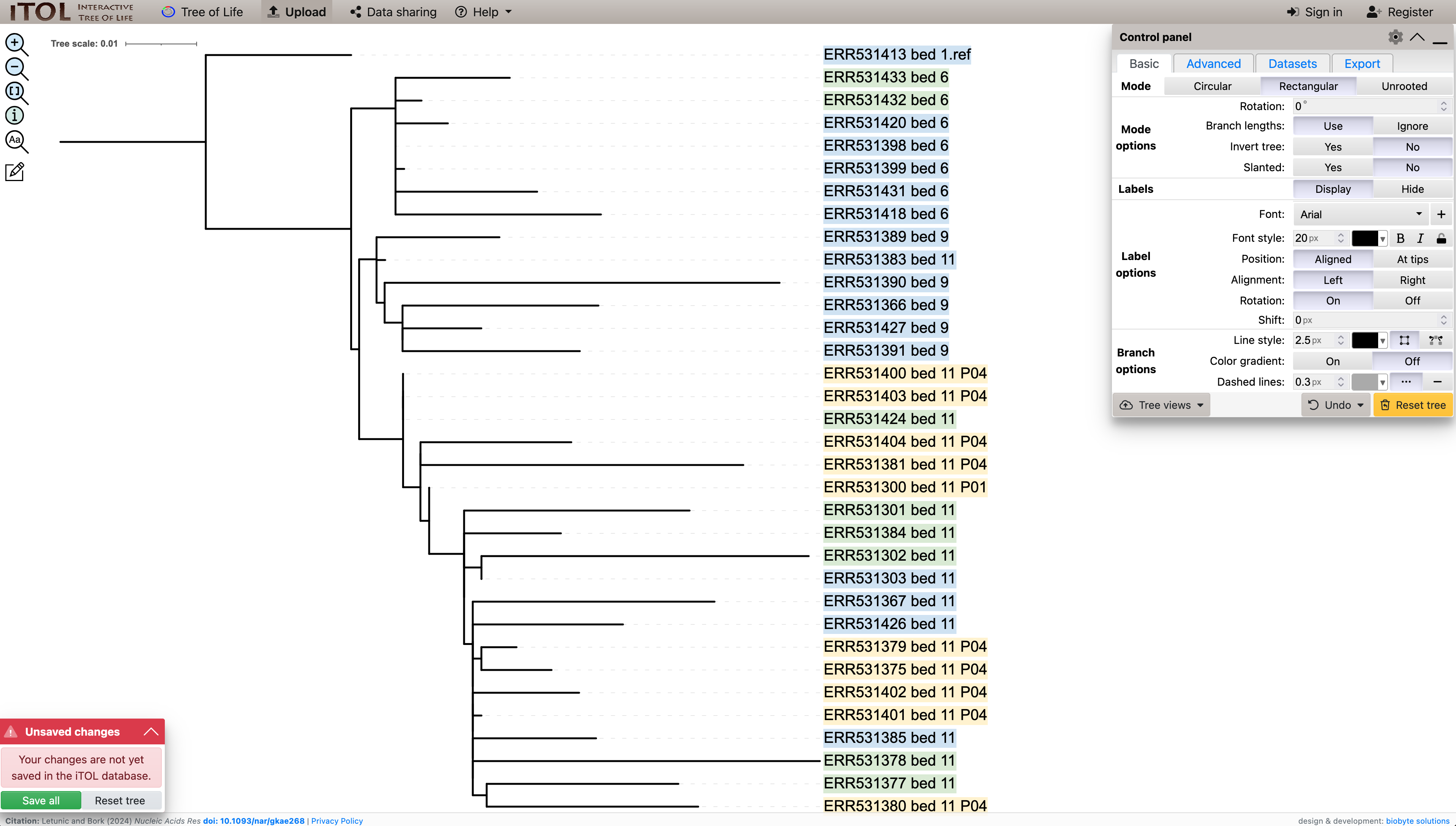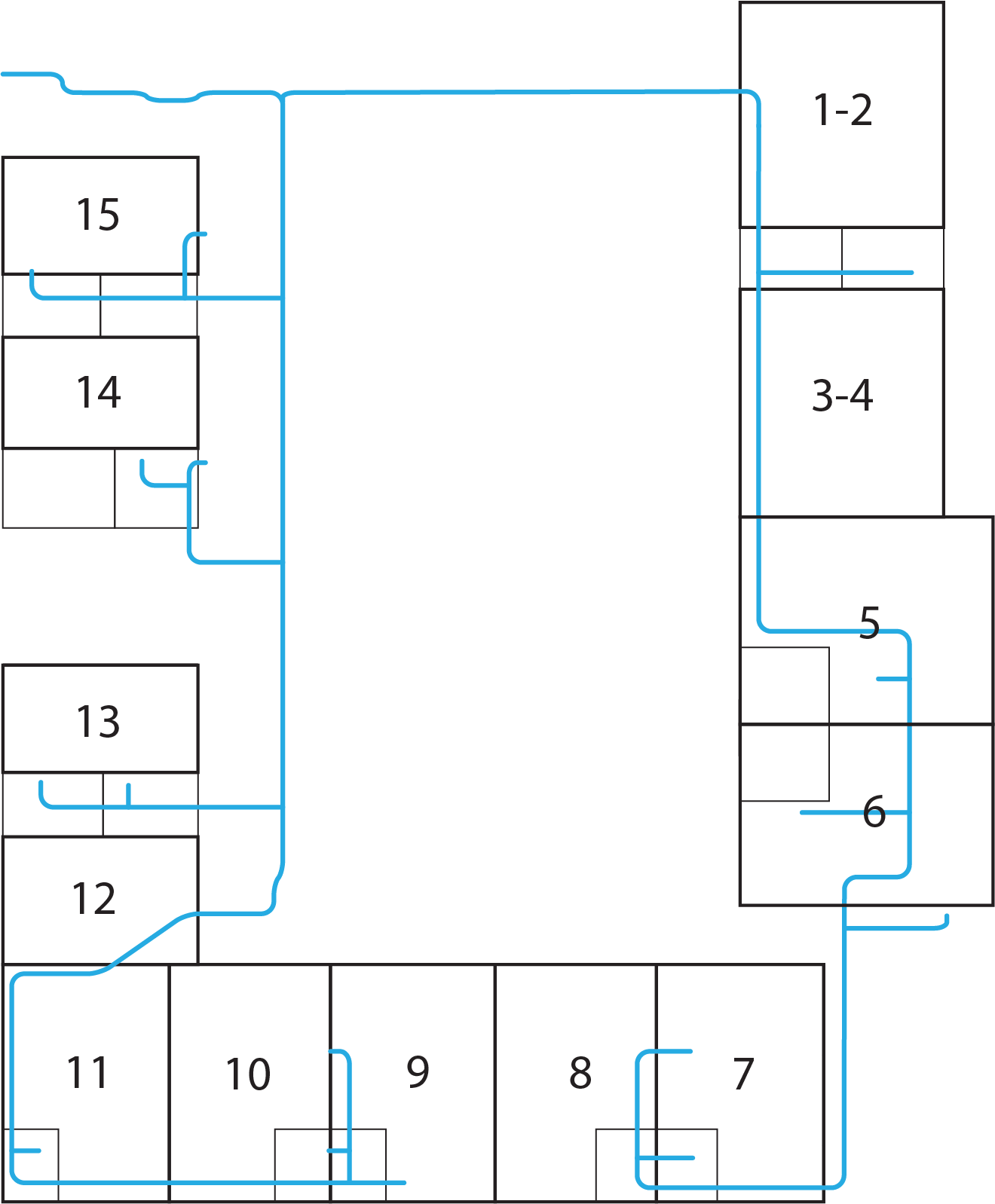15 Tracing the Source
You have constructed a phylogenetic tree similar to that in Figure 15.1 for each of the study isolates in Table 15.1. In this section, you will use this information, and the plan of the burns unit in Figure 15.2 to draw inferences about the likely routes of transmission of P. aeruginosa in the burns unit.
Work through the questions below to form your own conclusions concerning how the evidence you collected does or does not support hypotheses about particular routes of transmission.
ERR531413 roots the tree. The bed and patient from which each sample was taken is indicated in the branch labels. Branch labels are coloured by sample source: water (blue), environment (green), and patient (yellow).
Use what you know or can infer from Figure 15.2 and Table 15.1 to answer questions and determine the plausibility of the hypotheses below.
15.1 How does the burns unit layout influence potential routes of transmission?
15.1.1 Hypothesis 1
P. aeruginosa was introduced to the unit via the mains water system, which enters at the top left of Figure 15.2.
Assume that the pipes and fittings are contaminated in sequence, as water moves through the water system, and that P. aeruginosa is continuously accumulating mutations.
Consider each scenario below and decide which you think is most plausible, based on this hypothesis.
✗All of the isolates sampled from each bed will be identical, and a phylogenetic tree would not help trace contamination.
✓The earliest-contaminated beds on the left-hand side of the unit (9-15) will appear to share a distinct common ancestor from those on the right-hand side of the unit (1-8).
✗The isolates will appear to diverge from the initial contaminant in order of bed number (i.e. bed 1 samples diverge first, then bed 2 samples, then bed 3 samples).
✗The isolates will appear to diverge from the initial contaminant in reverse order of bed number (i.e. bed 15 samples diverge first, then bed 14 samples, then bed 3 samples).
Try tracing the possible paths through the pipe system, moving from the top left into the ward. Where are the branching points? If the P. aeruginosa isolates are constantly accumulating mutations, how might the branching points correspond to points on a phylogenetic tree?
Try sketching the tree you think you would see.
The flow of mains water would be expected always to be towards the outlets, and populations of P. aeruginosa that found themselves on the left-hand side of the ward would be unlikely to be able to move through the pipes to the right-hand side (and vice versa). If we assume initial contamination via mains water, and no subsequent cross-contamination between beds, we would expect beds 9-15 to share a common ancestor that is not shared by beds 1-8 (and vice versa).
Is the tree you constructed compatible with this hypothesis?
Do isolates from beds 9 and 11 share a common ancestor that is not shared with beds 1 or 6?
15.1.2 Hypothesis 2
P. aeruginosa isolates are transferred frequently between beds, for example by patient movement, clinician or nurse movement, or other poor infection control.
The ward is designed with side rooms to limit the amount of casual cross contamination that occurs.
Suppose that, despite this deliberate design effort, patient and staff movement frequently contaminates each bed with P. aeruginosa isolates from other beds.
Consider each scenario below and decide which you think would be most plausible, based on this hypothesis.
✓Isolates from several different beds would appear to share the same recent common ancestor, and it would not be possible to separate a phylogenetic tree into clades corresponding to individual beds.
✗Isolates from the same bed would appear to share a more recent common ancestor with each other than with isolates from any other bed.
✗Isolates from the left-hand side of the ward would appear to share a more recent common ancestor with each other than with isolates from the other side of the ward.
✗Isolates would appear to diverge from the same common ancestor in the order of bed number (bed 1 being most anciently diverged, bed 15 being most recently diverged).
What kinds of movements from room to room might you expect to see? Would there always be a pattern? Suppose you went into room 13 and picked up an isolate, then contaminated room 5 with it. What would the tree look like? What would the tree look like if you did this 100 times between different pairs of rooms?
The phylogenetic tree would still produce a history of the isolates that reflected the sequence of mutations that had occurred. The tree would have a clade structure, with groups of isolates that were more recently-diverged from a common ancestor than other groups. But, if there was frequent transfer of isolates between rooms, the clades would not correspond to any one location, and the isolates from any particular clade would be likely to be found in many different rooms.
Is the tree you constructed compatible with this hypothesis?
Is there a clade structure to your tree, where there is (more or less) one bed per clade?
15.2 Did the patients bring their own P. aeruginosa?
15.2.1 Hypothesis 3
Patients were already contaminated with a different strain of P. aeruginosa acquired from some other location (perhaps their home) before they took their beds on the ward.
Assume that the unit was already contaminated with P. aeruginosa, but that there is no cross-contamination between beds.
Assume that there is contamination between patient and bed.
Consider each scenario below and decide which you think would be plausible, based on this hypothesis.
✗Isolates sampled from the patient would closely resemble isolates sampled from other beds, but not their own bed.
✓Isolates sampled from the patient would closely resemble isolates sampled from their bed, but not other beds.
✓Isolates sampled from other beds in the unit would resemble isolates sampled from the patient.
✗Isolates sampled from the patient would not resemble any isolates sampled from the unit.
Contamination can be bidirectional. If a patient and their bed are in contact then material, including bacteria, can be transferred from the patient to the bed, and from the bed to the patient. More than one answer may be plausible.
If the patient introduces P. aeruginosa from an outside source to their bed, then isolates from that patient’s bed may resemble those from an outside source (but not other isolates from the unit). In the absence of cross-contamination, only that bed would carry an isolate that was introduced by the patient.
If the patient acquires P. aeruginosa from the previously-contaminated unit, and the isolates from each bed are related, then isolates from the patient may resemble those from any bed on the unit (though will likely be most similar to those from their own bed).
Is the tree you constructed compatible with this hypothesis?
Do the isolates sampled from patients resemble isolates sampled from the beds, or do they appear to be a different lineage entirely?
Is it possible that the study’s sampling strategy could pick up contamination in one direction (e.g. bed to patient), but not the other (patient to bed)?
Use the Days column from Table 15.1 (you may need to scroll to the right), and your tree, when considering each scenario below to decide which you think would be plausible, based on your evidence.
✗Patients P01 and P04 independently introduced from outside the burns unit two different lineages of P. aeruginosa that were sampled from their wounds.
✗Patient P01 introduced the strain sampled from both patients from outside the unit, contaminating bed 11. Later, patient P04 acquired this from bed 11.
✓Patients P01 and P04 each acquired the strain that was sampled from their wounds from bed 11.
✗Patient P04 introduced the strain sampled from both patients from outside the unit, contaminating bed 11.Later, patient P01 acquired this from bed 11.
The branching order of the tree implies the order of divergence of isolates, and patients can’t travel backwards in time to infect other patients. Use the data in Table 15.1 to check if time travel would be necessary for some of the options.
Patient P01 was sampled two months before patient P04 occupied the same bed, so P04 could not have contaminated them. Also, some of the isolates from PA04 appeared to diverge earlier than the isolate sampled from P01, and so are unlikely to have been introduced to the unit by P01. The close relation of isolates from P01 and P04 suggests that they were not independent lineages introduced to the burns unit. The close relationship of these isolates to the isolates from other beds suggests that they were not introduced to the unit from an external source.
Is the tree you constructed compatible with this hypothesis?
Do the isolates sampled from patients look to be distinct from those that were sampled from the unit’s environment and water system?
15.3 Next Steps
Please follow the link to the MyPlace formative quiz below and answer the questions.
Then read on to Chapter 16.

